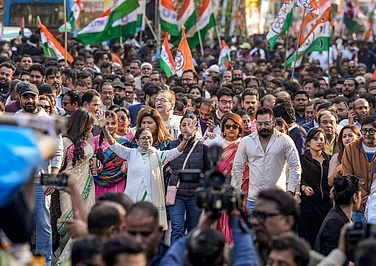On a furiously rainy night in September this year, Monica Dugba, 33, felt the first sharp pangs of pain, moments before her water broke. Over eight months pregnant, Dugba was not expecting the baby for another two weeks. She panicked. She lived in a remote hilly village called Lepchakha in Alipurduar, some 800 feet above the Buxa Tiger Reserve in north Bengal. There are no ambulance services in these hills; barely any road or cell phone connectivity. The nearest public health centre (PHC) was in Kalchini, about 30 km away. “I thought I would lose the baby,” she recalls. That’s when she called Tushar Chakraborty, general manager of the Family Planning Association (FPA), who manages the social organisation’s Kalchini branch.
Started in 1949, the FPA works on providing sexual and reproductive healthcare to women in India via a public-private partnership model. Since 2021, its Kalchini branch under Chakraborty’s vision, started an innovative service called the Palki Ambulance that seeks to provide easy and accessible transport services to pregnant women in remote areas. In one such Palki Ambulance, Dugba eventually gave birth. Both mother and baby are healthy after receiving treatment at the Kalchini PHC and maternity centre. The cost of her treatment was borne entirely by the West Bengal government.
Dugba’s case highlights the need for government intervention in healthcare, especially when it comes to ensuring women’s healthcare and reproductive rights. However, the recent shifts towards privatisation in healthcare as well as education can have catastrophic effects on women’s health and subsequently their right to physical safety and autonomy, claim experts.
India’s push towards privatisation in healthcare, education and the industrial sectors has tremendously improved the value delivered for prices charged—or “value for money”. But it has also resulted in inequitable distribution of benefits and resources between men and women. Studies such as the Oxfam 2021 Report on Inequalities showed that women from upper class, upper caste or Hindu backgrounds have a better access to healthcare, education and employment opportunities. Privatisation further sharpens this inequality. “Nothing in the private sector is free,” says Bijoya Roy from the Centre for Women’s Development Studies.
The Oxfam study showed that in India, expenditure for reproductive health-related diseases in private facilities is five times higher than in the public sector. Only a small percentage of women can access these. Data shows that as of 2022, 66 per cent of households in India have turned to private healthcare. The rest are dependent on the public sector or interventions by social organisations or NGOs. Roy, however, says privatisation impacted women’s overall healthcare, which depends largely on patriarchal control of resources. “The way a girl child’s health is perceived by the family shapes the way services are accessed,” says Roy.
Girl children are immunised less than boys, hospitalisation among women is lower, there is a delayed morbidity among women, meaning they will only seek medical help as a last resort, much later than men. “There are two reasons for this,” says Roy. “One is the overall decrease in labour force participation of women, especially after Covid. Second, women do not control the resources.” Financial independence is essential for control of resources, but during the pandemic, more women have lost their jobs—in formal and informal sectors—than men. Since 2020, there has also been a drop in women seeking employment.
A March 2019 report by Public Services International noted how the UN Independent Expert on Foreign Debt recognised that “downsizing and privatisation of state-owned companies often affected female employment disproportionately”. In the 2005 paper titled “An International Perspective of Privatization and Women Workers”, University of Hawaii researcher Ross Prizzia writes, “Among the workers of the world, women are all too often the most vulnerable and the most exploited during the adjustment and/or restructuring processes dominated by privatisation.” Another paper, “Why Privatising Government Services Might Hurt Women Workers” conducted by the Institute for Women’s Policy Research found that “women disproportionately depend on the public sector for jobs that pay decent wages and offer benefits” and a cut in such jobs due to privatisation may adversely affect them.
The International Labour Organization (ILO) has suggested several reasons for the drop in women's participation in the labour force in India over a number of decades, such as agriculture mechanisation, fewer job opportunities near their homes, especially in rural areas, and ultimately, social norms. Sher Verick, Head of Employment Strategies Unit ILO in Geneva , tells Outlook, “So in India, as households have become richer, women have withdrawn (also with education), though many indicate they would be willing to work outside the home if jobs were available in a sector/occupation that they could take up.”
Equal opportunities for women need to be supported by a number of policy measures, including creation of jobs, better infrastructure, safety and security and access to childcare facilities. An integrated policy for women’s employment is needed, he adds. To ensure equitable distribution of benefits, Verick says, “Privatisation in any country needs to be accompanied by a supportive policy package that is there to facilitate any adjustments that are a result of the measures taken and support the creation of jobs through investment and other channels so that women can also benefit.”
With India poised for a second wave of privatisation of industries, starting with Air India earlier this year, and a new National Education Policy pushing for increased PPP initiatives in education, activists feel the trends may not bode equally well for women across strata. “All private institutions, especially those providing technical, medical or managerial courses, charge exorbitantly high fees. Studies show that women are less likely to be considered for education loans and there is a clear preference for male children among most marginalised households, urban or rural, when it comes to education,” women’s rights activist and educationist Zakia Soman tells Outlook.
At present, India ranks 105 among 128 countries on UNESCO’s Education Development Index and scores very low in the gender-specific ‘Education for All’ category. Soman also pointed out that falling education levels among girls can directly be linked to falling participation of women in the labour force, and consequently, poor healthcare among women. “We have failed to make education widely accessible even after 75 years of Independence,” says Soman. “This is a failure of the government and to top it, there is privatisation. Girls were left out of even government schools,” says Soman. “There are a host of reasons for that, including safety, inaccessible geography, etc. But when it becomes an expensive affair at a private school, they are even more likely to be denied.”
According to the Annual Status Education Report 2019, there are more girls than boys in India’s government schools, and more boys than girls in private schools. In 2020-21, private schools accounted for 46.2 per cent of enrolment. But girls only made up 43.6 per cent of total students enrolling in elementary education in private institutions.
The relation of education to healthcare is best understood by studying the problems healthcare providers and facilitators like Chakraborty of FPA face in West Bengal. “A large part of our work involves advocacy and literacy training,” he says. “In most cases, women, especially in tribal areas, are resistant to modern medicine and mistrust medicinal interventions because of lack of literacy or education.”
A true push for women’s health requires interventions in education as well as financial agency in the long run. Privatisation in one sector automatically affects the other.
(This appeared in the print edition as "Smothering The Flame")


























